A Dahabiya Nile Cruise to Discover Egypts Treasures
Exploring ancient Egypt on a Dahabiya Nile cruise is an unique and sustainable way to explore the magnificence of ancient Egypt. This authentic and traditional mode of travel involves sailing on a small, authentic boat that harks back to the... The post A Dahabiya Nile Cruise to Discover Egypts Treasures appeared first on Green With Renvy.

Exploring ancient Egypt on a Dahabiya Nile cruise is an unique and sustainable way to explore the magnificence of ancient Egypt. This authentic and traditional mode of travel involves sailing on a small, authentic boat that harks back to the golden age of travel.
The word dahabiya is derived from the Arab word for “gold,” highlighting its ancient royal origins. The wooden sailboats, with only two decks and shallow bottoms, have been an option for travelers on the Nile since the 19th century and are based on designs that go back millennia.
An Environmentally-Friendly Way to Cruise
It should always be remembered that travel is a privilege. With it comes a certain amount of responsibility. Investigate any tour operator and make sure they are transparent with their data and actions. Don’t be fooled by greenwashing and companies trying to ride on the wave of responsible travel. As more and more people become environmentally conscious, it’s essential to find ways to explore the world while minimizing our impact on the environment. Responsible travel can easily be incorporated into your plans.
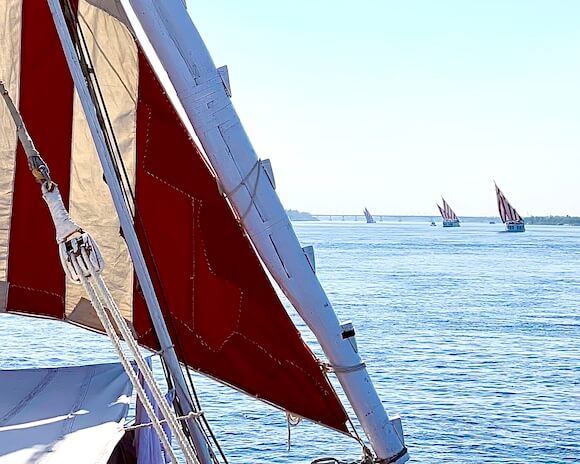
If you’re looking for a sustainable way to experience the beauty of the Nile River during a tour of Egypt, dahabiya cruising might just be your ticket to paradise. This type of small ship cruise is certainly unique.
In this article, we’ll explore what this unique, environmentally friendly mode of Egypt travel is, why it’s sustainable, and how you can take a responsible journey along the Nile without sacrificing any of the comforts or scenery. Sit back, relax and let’s sail into the world of traditional Dahabiya cruising.
What is Dahabiya cruising?
The Dahabiya has long been an important part of Egypt’s cultural heritage, dating back to the 19th century when it was a popular mode of transportation for wealthy travelers exploring the Nile.
Today, Dahabiya cruising remains a sustainable and environmentally friendly way to travel thanks to the efforts of local communities and tourism initiatives that prioritize ecological responsibility.
The boats are powered by the wind, using massive sails that catch the breeze and propel the vessel along, allowing passengers to experience the river in a way that’s both immersive and eco-friendly.

History of the Dahabiya
The history of the Dahabiya is fascinating and goes back to the time of the pharaohs. These beautiful boats were once the preserve of Egyptian royalty, designed for comfort and opulence as they sailed down the Nile. One can just imagine Cleopatra in recline being fanned with peacock feathers as she luxuriates on a daybed.
In the early 19th century, European adventurers began to embrace Dahabiya cruising. Travelers saw it as a means to explore the Nile in style. The routes covered travel from Cairo to Abu Simbel. Captains made their way powered by the river winds sailing from temple to temple. The boats continued use today highlights the importance of preserving traditions and cultural legacies.
At that time, Dahabiyas were exclusively powered by sails and relied on the wind to navigate the river. They had a distinctive design, with two large sails and a central mast that could be lowered to allow the boat to pass under low bridges. The boats were also equipped with a small kitchen, a dining area, and sleeping quarters for the crew and passengers.

Luxurious surroundings in the common area of a dahabiya.
Today, these beautiful boats have been given a new lease on life. They offer environmentally conscious travelers the chance to explore the Nile in a way that’s both sustainable and eco-friendly.
By choosing to travel with a responsible Dahabiya operator, you’re not just reducing your carbon footprint, you’re also supporting local communities and businesses. Many of the boats are owned and operated by local families, providing an income for the people who call the Nile their home.
Accommodations on a Dahabiya

A dahabiya cruise offers a unique and luxurious way to experience the beauty of the Nile River in Egypt. Dahabiyas are traditional sailing boats that have been refurbished to provide modern comfort and amenities. Accommodations on a dahabiya cruise typically vary depending on the specific boat and the level of luxury it offers. Here are some common features you might find:
- Cabins: Dahabiyas usually have a limited number of cabins, providing an intimate and personalized experience. Cabins are designed with traditional Egyptian decor and may include modern amenities such as air conditioning, en-suite bathrooms, and comfortable furnishings.
My Nile cruise with Nour el Nil provided all of the above. Gleaming white floors with walls. Rooms were accented with unique local antique textiles and accessories. Most had an Egyptian theme and the overall effect was “chic boho”. Read my full review of Nour el Nil on Quirky Cruise.
- Common Areas: There are common areas for socializing and relaxation. These can include a spacious lounge, dining areas, and sometimes a sundeck with loungers. The decor often reflects a blend of traditional and modern styles.
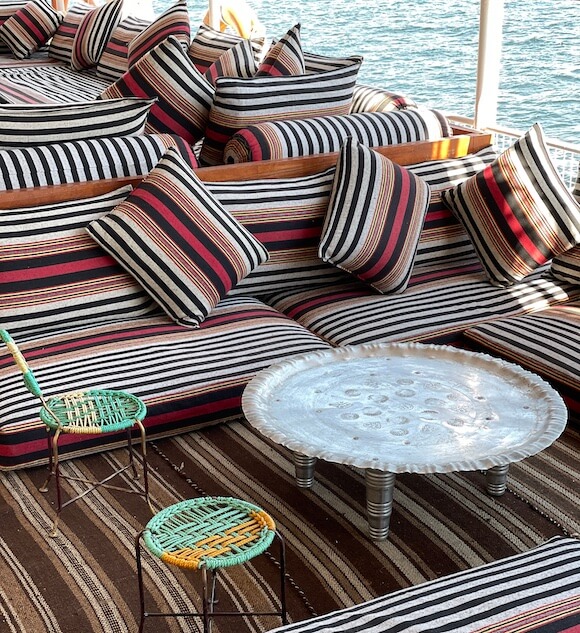
- Dining: Meals are an essential part of the dahabiya experience. Onboard chefs prepare a variety of local and international dishes, often using fresh, locally sourced ingredients. Dining can take place in a dedicated dining area or on the deck, offering stunning views of the Nile.
- Crew and Service: A dedicated crew, including a captain, chef, and support staff, ensures that guests have a comfortable and enjoyable experience. The service is typically attentive and personalized, creating a relaxed and welcoming atmosphere.
- Cruise Itinerary: Dahabiya cruises often follow a more relaxed pace, allowing guests to explore less crowded sites along the Nile. The itinerary may include stops at archaeological sites, temples, and villages, providing a more immersive cultural experience.
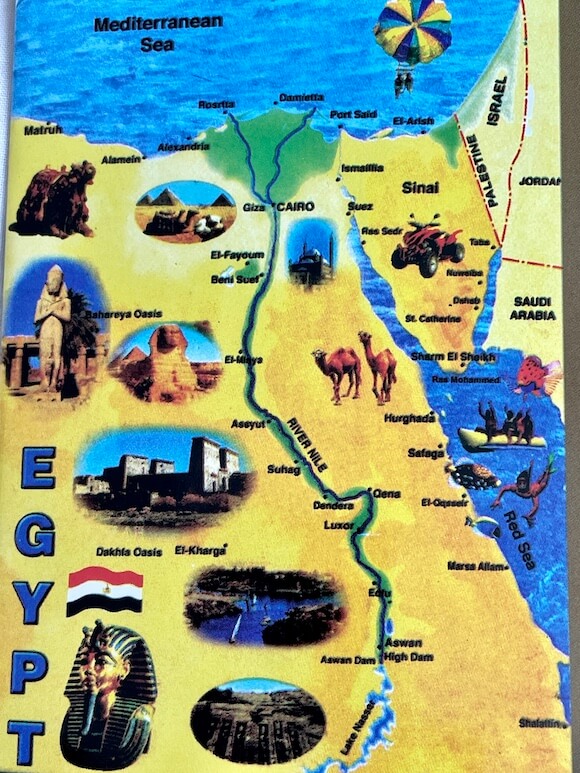
- Entertainment: Some dahabiyas offer entertainment options such as live music, traditional dance performances, or lectures on Egypt’s history and culture.
- Themed Cruises: Some operators offer themed cruises with specialized focuses, such as birdwatching, photography, or wellness. These cruises may include additional amenities and activities tailored to the theme.
Insider Tip: It’s important to note that while dahabiyas offer a more intimate and traditional experience compared to larger cruise ships, the level of luxury can vary substantially. It’s advisable to check the specific details and amenities offered by the dahabiya you’re considering to ensure it aligns with your preferences and expectations.
Food and Flavors on a Dahabiya Cruise
The food on a dahabiya cruise is typically one of the highlights of the experience, offering a blend of traditional Egyptian cuisine and international dishes. The culinary offerings aim to provide guests with a diverse and flavorful dining experience. The small boats have the advantage of stopping along the itinerary and buying whatever is fresh in the local markets. Here are some aspects of the food on a dahabiya:

Local flavors and cuisine on my Nile dahabiya cruise on the Nile river.
- Local Flavors: The onboard chefs often incorporate local and seasonal ingredients, giving guests a taste of authentic Egyptian flavors. Expect dishes featuring staples like falafel, koshari, stuffed grape leaves, and a variety of grilled meats and fish.
- Variety of Dishes: Dahabiya cruises usually offer a varied menu with a mix of Egyptian specialties and international cuisine. Meals typically include options for vegetarians and those with dietary restrictions or preferences.
- Fresh Ingredients: Given the cruise’s location along the Nile, chefs have access to fresh produce, fish, and other local ingredients. This ensures that meals are not only delicious but also reflect the quality of the region’s culinary offerings.
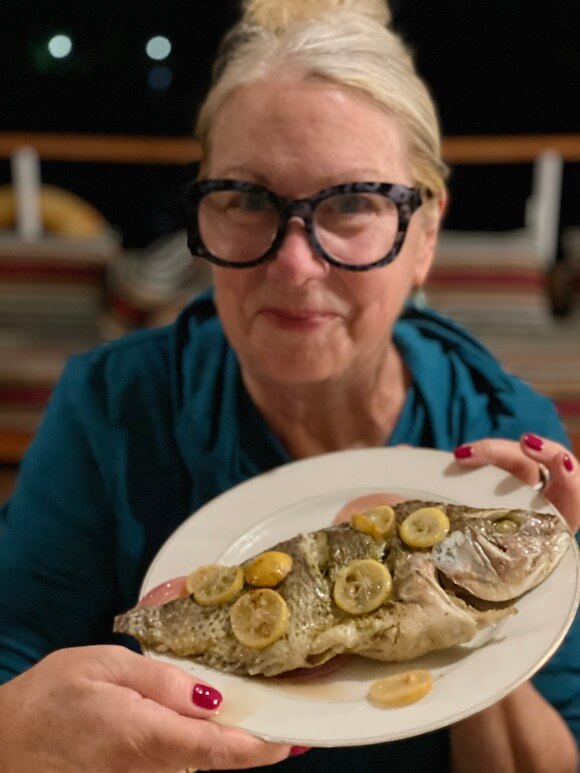
Local fish caught daily for my pescatarian diet.
- Dining Locations: Meals can be served in a designated dining area inside the boat or on the deck, allowing guests to enjoy their food while taking in scenic views of the Nile River and its surroundings.
- Customization: Some dahabiya cruises may offer the opportunity for guests to request specific dishes or accommodate dietary restrictions. It’s advisable to communicate any dietary preferences or restrictions in advance to ensure a more personalized dining experience. This is especially true for any allergies.
- Culinary Events: Depending on the cruise, there may be special culinary events such as barbecue nights on the deck, themed dinners, or cooking demonstrations where guests can learn about the preparation of local dishes.
- Traditional Meals: Guests often have the chance to try traditional Egyptian meals, including dishes like kofta (grilled minced meat), mezze platters, and various types of bread such as flatbreads and pita.
- Desserts and Sweets: Egyptian desserts are known for their rich flavors and use of ingredients like dates, nuts, and honey. Expect to enjoy treats like baklava, basbousa (semolina cake), and qatayef (stuffed pastries) during your cruise.
The culinary experience on a dahabiya cruise is part of the overall cultural immersion, allowing guests to savor the tastes of Egypt while enjoying the serene and picturesque surroundings of the Nile. Keep in mind that the specific Nile cruise offers can vary depending on the tour operator and the itinerary.
Sites to See on Dahabiya Nile Cruises
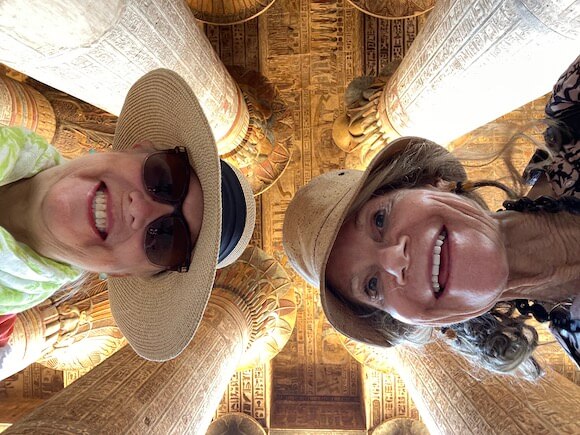
Some of the must-see sites along the Nile include tours of the temples of Karnak, Luxor, the Valley of the Kings, the Colossi of Memnon among others. Abu Simbel and Lake Nasser are often visited from Aswan. All of these magnificent Egyptian sites are usually visited on a pre or post Nile combination of day tours. Together, superb sightseeing is the result of a well-planned itinerary to this bucket list country.
Most tourists select an itinerary from three to seven days on a Nile cruise. The usual port of embarkation is Luxor (nearby Esna). Travel continues along the Nile to Aswan (or Aswan to Luxor). As passengers cruise down the Nile on a Dahabiya, they will encounter a wealth of notable landmarks and breathtaking sights.
El Kab, Edfu, Gebel Silsileh and Kom Ombu are four of the sights included in my itinerary. The journey offers a unique opportunity to explore ancient Egyptian temples, tombs, and monuments that are steeped in history and culture. If you have the time, a glorious end to a Nile cruise is a stay at the Old Cataract Hotel in Aswan.
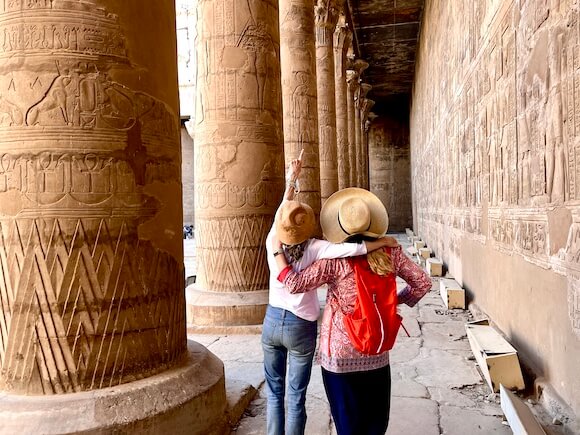
Exploring the treasures of Edfu, Egypt.
Because of their smaller size, dahabiya Nile sailing offers the unique characteristic of being able to anchor in many places the larger boats can not explore. Passengers will have the opportunity to visit unusual sites and off the beaten path locations. Larger cruise ships are usually limited to 2-3 dockings along the route depending on length of itinerary.
In addition to these historic landmarks and exclusive destinations, Dahabiya cruisers can also enjoy the stunning natural beauty of the Nile River and its surroundings. The river is lined with lush greenery, palm trees, and date groves, making for a scenic and peaceful journey. Along the way, travelers can spot a variety of wildlife, including birds, crocodiles, and baboons.
Why is a Dahabiya Cruise Sustainable?
The use of solar panels and low-emission engines on modern-day Dahabiyas reduces carbon emissions and minimizes the impact on surrounding ecosystems. Furthermore, some of the boats are equipped with waste management systems to ensure that no trash is left behind in the pristine natural environments along the Nile. On demand hot water systems reduce water consumption.
By choosing to travel via Dahabiya, tourists are supporting sustainable tourism initiatives that contribute to the livelihoods of local communities. Local guides and crew members are trained in responsible tourism practices, providing visitors with the opportunity to support the preservation of traditions while immersing themselves in the local culture.
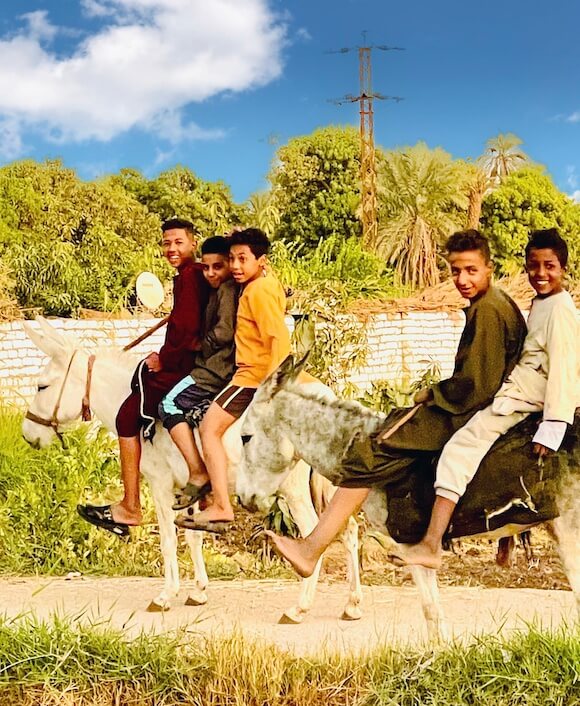
As with all small ship cruising, fewer passengers allows guests to visit communities and experience village life along the river, contributing to a memorable cross-cultural journey.
Reducing fuel consumption with wind power
A Nile dahabiya cruise is an opportunity to minimize fuel consumption through the use of wind power. The Dahabiya, with its enormous sails, takes advantage of the wind, only using the auxiliary tug boat when necessary. reducing the need for engine power.
The use of wind power not only conserves fuel but also adds to the unique and authentic experience of sailing the Nile, as it has been done for centuries. This design is practical and provides a serene and peaceful journey. This is in sharp contrast to many of the other black soot emitting cruises we passed on the Nile.

Supporting local communities
The Dahabiya’s dedication to sustainability extends beyond its eco-friendly methods of transportation. By choosing to embark on a Dahabiya cruise, travelers are actively supporting local communities along the Nile valley who rely on the tourism industry for their livelihood.
Many of the crew members aboard the Dahabiya boats are locals who have grown up along the river and have a deep-rooted connection to the land and its people. By providing employment opportunities and investing in local businesses, Dahabiya cruises contribute to the economic growth and cultural preservation of the surrounding communities.

Nour el Nile dahabiyas ©Mandy Davies
Through local partnerships and collaborations, the Dahabiya works to promote responsible tourism practices and create a positive impact on both the environment and the people who call the Nile home. This commitment to sustainable travel allows visitors to experience the beauty of the Nile without leaving a negative footprint behind.
Moreover, a responsible Dahabiya company provides travelers with ample opportunities to interact with the local communities and learn about their way of life, from meeting with artisans and farmers to visiting historic sites with expert guides. This not only makes for a more fulfilling travel experience, but also helps to promote cultural exchange and understanding.
Conclusion – Dahabiya Cruising and Responsible Travel
Ultimately, by experiencing the beauty of the Nile in a responsible and mindful way, travelers can create lasting memories while also contributing to a more sustainable and equitable tourism industry. In doing so, they can be part of a movement that seeks to preserve and protect the world’s most precious natural and cultural resources for generations to come.
Dahabiya cruising with an ethical company offers a sustainable and environmentally-friendly option for travelers looking to explore the Nile River. By reducing fuel consumption with wind power and supporting local communities, these cruises prioritize responsible tourism while providing a unique and authentic experience.
As we strive to make more conscious choices about our impact on the planet, dahabiya cruising in Egypt stands out as a responsible way to travel. If you’re looking to minimize your carbon footprint while enjoying the stunning beauty in the land of the pyramids, consider a dahabiya cruise for your next adventure. As the saying goes, “When it comes to cruising, SIZE matters!”

Essential Travel Tips for Egypt
The Best Sites from Cairo to the Giza Pyramids
The post A Dahabiya Nile Cruise to Discover Egypts Treasures appeared first on Green With Renvy.

 vigna
vigna 





